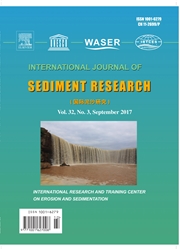

 中文摘要:
中文摘要:
一个 Euler-Lagrange 二阶段的流动模型被开发与使用在沉积散开上考虑液体骚乱的效果的一个埃迪相互作用模型(EIM ) 一起由开隧道的流动学习推迟的沉积运输。为连续阶段,吝啬的液体速度,狂暴的动能和它的驱散率被生长得很好的实验公式直接估计。为驱散的阶段,沉积粒子被解决运动的方程追踪。EIM 被使用计算粒子变化速度。在是的流动骚乱上忽视粒子的效果通常建议了为冲淡在文学的盒子, Euler-Lagrange 模型被使用在开的隧道模仿推迟的沉积运输。尽管数字结果为好沉积盒子由追踪模型(RWM ) 的著名随机的散步粒子并且与实验室数据与那些同意很好,如此的一个 Euler-Lagrange 模型为中型、粗糙的沉积盒子低估沉积集中,这清楚地被显示出。为了改进模型,,一个公式被建议由于旋涡在 wake 流在一个粒子附近考虑本地液体骚乱改进。修改模型的数字结果然后为不仅罚款而且粗糙的沉积盒子与实验室数据同意很好。
 英文摘要:
英文摘要:
An Euler-Lagrange two-phase flow model is developed to study suspended sediment transport by open- channel flows with an Eddy Interaction Model (ELM) applied to consider the effect of fluid turbulence on sediment diffusion. For the continuous phase, the mean fluid velocity, the tui-bulent kinetic energy and its dissipation rate are directly estimated by well-established empirical formulas. For the dispersed phase, sediment particles are tracked by solving the equation of motion. The ElM is applied to compute the particle fluctuation velocity. Neglecting the effect of particles on flow turbulence as usually suggested for dilute cases in the literature, the Euler-Lagrange model is applied to simulate suspended sediment transport in open channels. Although the numerical results agree well with those by the well- known random walk particle tracking model (RWM) and with the laboratory data for fine sediment cases, it is clearly shown that such an Euler-Lagrange model underestimates the sediment concentration for the medium-sized and coarse sediment cases. To improve the model, a formula is proposed to consider the local fluid turbulence enhancement around a particle due to vortex shedding in the wake. Numerical results of the modified model then agree very well with laboratory data for not only the fine but also the coarse sediment cases.
 同期刊论文项目
同期刊论文项目
 同项目期刊论文
同项目期刊论文
 期刊信息
期刊信息
